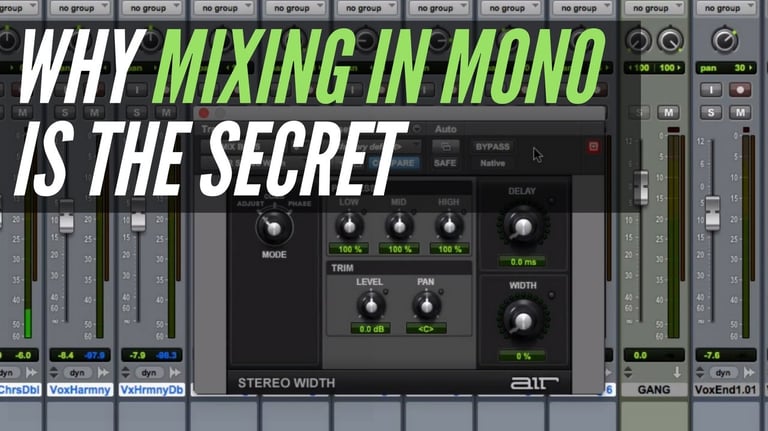UNLOCK THE SECRET TO BIGGER, WIDER MIXES: THE POWER OF MIXING IN MONO 🎧Your blog post
Ever wondered how to make your music sound fuller, wider, and more professional? The answer may surprise you: mix in mono. While it might seem counterintuitive, this classic technique is a game-changer for music producers at any level. In this post, we’ll dive into the power of mono mixing, how it enhances your tracks, and why it’s the secret weapon for achieving stellar stereo mixes. Let’s get started! 🎶
Why Mono? Understanding the Magic Behind It
Mixing in mono can feel strange at first, especially in a world where stereo reigns supreme. So why bother? The answer lies in clarity and balance. By collapsing your mix to mono, you can easily identify problem areas where instruments clash or "hide" behind each other. It forces you to focus on the raw elements and ensures that each instrument has its own sonic space.
As explained in the demonstration, “mixing in mono helps you get the clarity out of your instruments, your songs. You can hear the details.” When done right, mono mixing guarantees that your final stereo mix will be wider, fuller, and more cohesive.
How to Mix in Mono: A Step-by-Step Guide
Ready to try it for yourself? Here’s a simple guide to start mixing in mono and elevating your tracks:
- Switch to Mono: Begin by toggling your mix to mono. Most digital audio workstations (DAWs) have this option, usually represented by an "M" button.
- Focus on Balance: Listen carefully to the instruments in your mix. Pay attention to areas where sounds overlap or compete for space.
- Pan and Adjust: Even in mono, you can make adjustments like panning and EQ. This helps you fine-tune the mix so every element stands out, even in a single channel.
- Test in Stereo: Once you’re happy with your mono mix, switch back to stereo and revel in the newfound width and fullness of your track!
As the speaker demonstrated, switching between mono and stereo during the process allows you to hear the dramatic difference. “If you can hear the distinction of two instruments in mono, I guarantee when you put it in stereo, it’s just going to sound that much better, that much wider, that much fuller.”
watch video here: https://youtu.be/L2c-_r41IN0
The Benefits of Mixing in Mono
Beyond improving clarity and balance, mixing in mono offers several practical advantages:
- Problem Detection: It helps uncover frequency clashes and muddiness, making it easier to fix overlapping sounds.
- Universal Playback: Many environments like stores, elevators, and even certain radio systems still play music in mono. A mix that sounds good in mono will translate well anywhere.
- Better Stereo Impact: When you nail your mono mix, switching to stereo will amplify the depth and width of your sound.
While the process may feel “weird” at first, it’s worth the effort. The speaker emphasizes, “Once you get past that weirdness, you’ll start hearing better and finding those little holes in your mix.”
Final Thoughts: A Mono Mix for a Stereo World
Mixing in mono might seem like an old-school trick, but its benefits are timeless. By forcing you to focus on the essentials, it creates a solid foundation for a powerful stereo mix. Whether you’re a beginner experimenting in your home studio or a seasoned producer looking for that extra edge, mono mixing is a technique you can’t afford to ignore.
So, are you ready to transform your mixes? Start mixing in mono today and experience the difference for yourself. Have you tried this technique before? Share your thoughts and results in the comments below! And don’t forget to subscribe for more pro tips on mixing, recording, and music production. Let’s make your sound shine! 🌟


